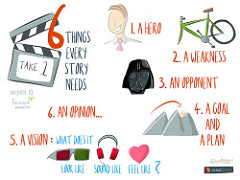
When your donors open your appeal letter or newsletter, do you bore them with a bunch of mind-numbing statistics, or do you share a story about how the Wilson family moved out of a shelter and into a home of their own?
If you’re making a difference, you have stories to tell
Donors love stories. Stories bring the work you do to life by using everyday language to create a scene. Here’s an example.
Diane woke up feeling good for the first time in awhile. After losing her job and being evicted from her apartment, she moved between her sister’s place, motels, and shelters. It was taking a toll on her family and her kids were falling behind in school.
That was about to change because thanks to donors like you, Diane and her family will be moving into a home of their own.
Can you tell a story like that? If you’re making a difference, you can. Stories should show your donors how they’re helping you making a difference for the people you serve.
Create a culture of storytelling
If you create a storytelling culture in your organization, you can make storytelling the norm instead of the exception.
Creating stories takes a little more work, but they will help you connect with your donors. When you put together a story, ask.
- Why would your donors be interested in this story?
- Why is this important?
- Are you using clear, everyday language (no jargon) to make sure your donors understand your story?
- Who are you helping?
- How are your donors helping you make a difference?
Client or program recipient stories are best. You’ll need to work together with your program staff to get these stories. Everyone needs to understand how important this is. Share stories at staff meetings and/or set up regular meetings with program staff to gather stories.
Another way to find stories is to put a Share Your Story page on your website. Share-Your-Story Page | an addition to the fundraiser’s arsenal of tools
You can also share profiles of volunteers, board members, and donors. Many organizations profile new board members in their newsletters. That’s okay, but instead of emphasizing their professional background, concentrate on what drew them to your organization. Perhaps she benefited from having a tutor when she was in school or he’s passionate about human rights.
Create a story bank to help you organize all your stories. Take advantage of slower times of the year to gather stories. You want to use stories often. Use them in your appeal letters, thank you letters, newsletters, annual reports, website, blog, and other types of social media. You can use the same stories in different channels.
Give your stories the personal touch
Use people’s names to make your stories more personal. I realize you might run into confidentiality issues, but you can change names to protect someone’s privacy. You could also do a composite story, but don’t make up anything. Fundraising with Names Have Been Changed Disclaimers
Your stories aren’t about your organization
Let your donors know how with their help, Janet doesn’t have to choose between buying groceries and paying the heating bill. Your organization stays in the background. And remember, Your Mission Statement is NOT Your Story
Connect with your donors by telling them a story. In my next post, I’ll write about sharing visual stories.
Resources to help you tell your stories
[…] Connect With Your Donors by Telling Stories – “If you create a storytelling culture in your organization, you can make storytelling the norm instead of the exception.” Read now >> […]
LikeLike
[…] Connect With Your Donors by Telling Stories […]
LikeLike
[…] Connect With Your Donors by Telling Stories […]
LikeLike
[…] One way to burst past generic language and jargon is to tell stories. Most people respond better to a human-interest story than a bunch of boring statistics. Connect With Your Donors by Telling Stories […]
LikeLike